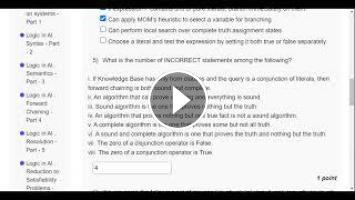NPTEL An Introduction to Artificial Intelligence Week 7 Assignment 7 Solutions Jan-Apr 2024 quiz 7
Draft version.. uploaded.. please keep watcing my description for updates
I think it is a bit tough this week unless you are good at Discrete mathematics.... (please comment on this)
Can not say how many will be correct...I need to work on this again. So But watch for my updates
Updates after posting the video
Summary of updates
1) Q 8 - Answer 4
2) Q 1: Answers 1,2
3) Q 7 Answers may be 1,2,3
4) Q5 : Answer 2
5) Q6 : Answer 0
6) Q 10: 3
7) Q 4: 1,2,4
closing the updates now.. This quiz seems to be a little bit tough...
Will wait for the results tomorrow
You should have got 77 .. left a couple of options to be on safe side... hectic week....
Basis for changing the answer
1) Correction Q8 . The answer should be 4 not i,ii,iii,iv
2) Q 1: Answers 1,2 may be correct as per my thinking. Syntax Semantics are components of Knowledge Representation Language . If we add Inference Procedure Knowledge Base also it might become Knowledge Representation system. However think once again if you think 3 or 4 (or both ) should also be included. (I would not risk maring 3,4 ) any comments on this...
3) Q7 Answers may be 1,2,3.. I think we can resolve in different ways. I have resolved in the following 2 ways
Knowledge base ({¬a ∨ b}, {¬b}, {¬c ∨ b}, {a ∨ d}, {c ∨ ¬d})
First)
¬a {¬c ∨ b}, {a ∨ d}, {c ∨ ¬d}
¬a {¬c ∨ b}, {a ∨ c }
{¬c ∨ b} c
b
second)
{¬a ∨ b}, {¬b}, {¬c ∨ b}, {a ∨ d}, {c ∨ ¬d}
{¬a ∨ b}, ¬c {a ∨ d}, {c ∨ ¬d}
{d ∨ b}¬c {c ∨ ¬d}
{d ∨ b} ¬d
b
Thus we got ¬a, ¬c, ¬d as the answer (did not get empty clause)
Q5 : I think the answer is 2 False statements They are 4,5 (For information)
Q 6 : Answer should be 0
{(a, ¬b, c), (c), (¬c, d, ¬e), (¬a, ¬b, e), (a, ¬b, ¬c), (d, b), (e, a)}.
Setting unit literal c to true
{ ( d, ¬e), (¬a, ¬b, e), (a, ¬b, ), (d, b), (e, a)}.
setting pure literal d to true
(¬a, ¬b, e), (a, ¬b, ) (e, a)
setting pure literal e to true
(a, ¬b, )
setting pure literal a to true
¬b
setting pure literal ¬b to true
{} empty clause
Thus empty clause remains... answer should be 0 (assuming empty clause is not counted Any one any other thoughts
Please comment for any clarifications/ improvement suggestions
Q 10 Need to check once again
Q4: Any one thinks option 4 is also correct apart form 1,2?
Draft version.. uploaded.. please keep watcing my description for updates
I think it is a bit tough this week unless you are good at Discrete mathematics.... (please comment on this)
Can not say how many will be correct...I need to work on this again. So But watch for my updates
Updates after posting the video
Summary of updates
1) Q 8 - Answer 4
2) Q 1: Answers 1,2
3) Q 7 Answers may be 1,2,3
4) Q5 : Answer 2
5) Q6 : Answer 0
6) Q 10: 3
7) Q 4: 1,2,4
closing the updates now.. This quiz seems to be a little bit tough...
Will wait for the results tomorrow
You should have got 77 .. left a couple of options to be on safe side... hectic week....
Basis for changing the answer
1) Correction Q8 . The answer should be 4 not i,ii,iii,iv
2) Q 1: Answers 1,2 may be correct as per my thinking. Syntax Semantics are components of Knowledge Representation Language . If we add Inference Procedure Knowledge Base also it might become Knowledge Representation system. However think once again if you think 3 or 4 (or both ) should also be included. (I would not risk maring 3,4 ) any comments on this...
3) Q7 Answers may be 1,2,3.. I think we can resolve in different ways. I have resolved in the following 2 ways
Knowledge base ({¬a ∨ b}, {¬b}, {¬c ∨ b}, {a ∨ d}, {c ∨ ¬d})
First)
¬a {¬c ∨ b}, {a ∨ d}, {c ∨ ¬d}
¬a {¬c ∨ b}, {a ∨ c }
{¬c ∨ b} c
b
second)
{¬a ∨ b}, {¬b}, {¬c ∨ b}, {a ∨ d}, {c ∨ ¬d}
{¬a ∨ b}, ¬c {a ∨ d}, {c ∨ ¬d}
{d ∨ b}¬c {c ∨ ¬d}
{d ∨ b} ¬d
b
Thus we got ¬a, ¬c, ¬d as the answer (did not get empty clause)
Q5 : I think the answer is 2 False statements They are 4,5 (For information)
Q 6 : Answer should be 0
{(a, ¬b, c), (c), (¬c, d, ¬e), (¬a, ¬b, e), (a, ¬b, ¬c), (d, b), (e, a)}.
Setting unit literal c to true
{ ( d, ¬e), (¬a, ¬b, e), (a, ¬b, ), (d, b), (e, a)}.
setting pure literal d to true
(¬a, ¬b, e), (a, ¬b, ) (e, a)
setting pure literal e to true
(a, ¬b, )
setting pure literal a to true
¬b
setting pure literal ¬b to true
{} empty clause
Thus empty clause remains... answer should be 0 (assuming empty clause is not counted Any one any other thoughts
Please comment for any clarifications/ improvement suggestions
Q 10 Need to check once again
Q4: Any one thinks option 4 is also correct apart form 1,2?












Comments